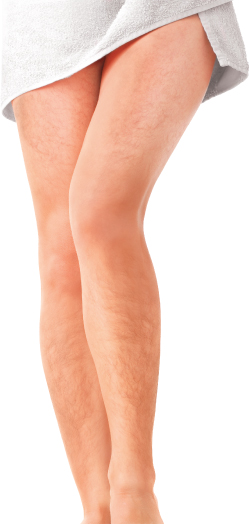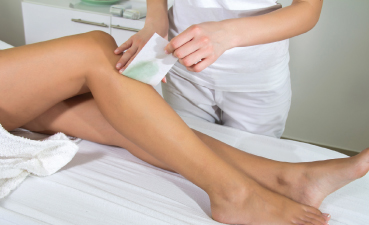Excess hair presents an embarrassing problem as many women around the world participate in some form of hair removal. While cosmetic concerns are a determining factor in hair removal, some clients may be dealing with a more serious issue. Unwanted hair may not just be cosmetic when presented with a client suffering from excessive hair growth but it can also be a sign of a medical condition. Having unwanted hair is an issue that attributes to an emotional burden, such as low self-esteem and depression, in the individual.
Normal hair growth patterns vary due to age, sex and race but the pilosebaceous follicle is ultimately controlled by hormones. More specifically, the rate of hair growth is androgen dependent. When the body reaches sexual maturity, sex hormones, including androgen, cause the vellus hair on specific parts of the body to become terminal hairs. These hairs are dark, coarser and sometimes curlier. When unwanted terminal hair grows on the body, it can be caused by multiple conditions that every aesthetician should be aware of in order to effectively treat their clients.
 Conditions That Affect Hair Growth
Conditions That Affect Hair Growth
While some excess hair growth may be idiopathic (present on the body for no medical reason), other clients with this symptom may be suffering from an underlying hormone abnormality. It is necessary to obtain a medical history during the consultation process with your client before recommending a hair removal treatment option. If your client begins to notice rapidly growing hair, especially in places such as the upper lip, cheeks, neck, chin, chest or lower back; irregular hair growth in association with an irregular menstrual cycle; male features such as deepening of the voice, balding, and decreased breast size; or hair growth worsening in correlation with a medication, you should recommend that the client seek medical advice.

Understanding the various conditions that can be the root of unwanted hair growth will enable you to provide the best care for your clients; but remember to always refer them to a physician for further medical examination.
Hirsutism
Hirsutism is classified by excessive hair growth in women that resembles hair patterns typically found in males. Women who have this condition will likely see hair appear on their upper lip, neck, chin, cheeks, abdomen, chest and lower back. Hirsutism is considered a fairly common condition among women; however, some women may present coarse, pigmented hair in these general areas but may not be considered hirsute. Hormones always play a role in hirsutism, however, this does not always mean that there is an abnormality in the glands. The hair follicle can also be the cause due to an overreaction to a normal level of androgens causing the excessive hair growth. Since hirsutism is a hormone disorder, aestheticians should be mindful that excessive hair growth will not necessarily be the only symptom that affects the client. Androgens can cause an overproduction of sebum that may lead to acne. Clients with this condition can be prescribed medication by their medical doctor that will aid in the reduction of androgens produced and help to reduce the amount of unwanted, pigmented hair.
While a prescription can reduce the growth of hair, hirsutism is not a curable condition and can only be suppressed through medication or alleviated with hair removal methods. Possible conditions that may cause hirsutism include:
- Adrenal gland dysfunction – also known as congenital adrenal hyperplasia, a genetic condition that can cause an increase in male hormones in women. While this condition is fairly uncommon, it can be caused by an abnormality in hormone production that begins at birth or later in life. Clients with adrenal gland dysfunction can also suffer from acne and/or hair loss on the scalp.
- Cushings syndrome – when your body is exposed to stress, it produces the hormone cortisol that is made in the body’s adrenal glands. Cushings syndrome arises when the body is consistently exposed to high levels of cortisol, either due to stress, a dysfunction, or from taking a cortisol-like medication. Sex hormones, like androgens, are disrupted by the high levels of cortisol and cause excess hair growth.
- Polycystic ovary syndrome (PCOS) – occurs due to an overproduction of androgens in a woman’s ovaries. Unfortunately, PCOS is a commonly diagnosed ovarian problem that can lead to infertility, problems with ovulation, ovarian cysts, weight gain, and excessive hair growth.
- Tumors – if a client has a sudden onset of excessive hair growth or has an extreme case of unwanted hair, it is possible (but rare) that the client may have a tumor in her ovaries, adrenal or pituitary gland that is causing an increase in male hormones.
Hypertrichosis
Unlike hirsutism, hypertrichosis is not brought on by hormones but is characterized by an increase of hair growth anywhere on the body; it can develop in small, localized patches or all over. This condition can be present at birth or may arise later in life. Currently, congenitial hypertrichosis (present at birth) has no known cure, however, acquired hypertrichosis can be treated by finding the root cause. For instance, some cases of hypertrichosis can be brought on by medication, so a physician would need to evaluate the case and consider removing the prescription from the client’s medical regimen. Both congential and acquired hypertrichosis can be temporarily or permanently alleviated through hair removal methods.
 Hair Removal Methods
Hair Removal Methods
If a client has unwanted hair, the first step is to assure them they are not alone and present them with safe hair removal choices. If you have built a relationship of trust with your client, it will be a more comfortable experience for each of you when discussing unwanted hair and the best removal method for them. Always listen to your client’s responses and concerns and be sure you understand their wants and needs when it comes to hair removal.
All methods of hair removal are not appropriate for all clients or all areas of the body. It is necessary to educate yourself on the hair removal methods based on type of hair, body area, and amount of hair growth, and correlate them to the client’s age, hair type and preferences. Familiarize yourself with the two forms of hair removal: depilation and epilation. Depilation will only remove hair on the surface of the skin and does not offer a permanent solution for the client, while epilation will remove the entire hair, providing the client with a much longer period between treatments. Offer a range of services that enables your client to choose the treatment that best fits their lifestyle and condition. It is beneficial to offer maintenance services, such as waxing or dermaplaning, and a more permanent option, such as laser hair removal. While there is a vast array of hair removal options, here are a few of the most efficient.
- Electrolysis – a permanent method of hair removal. It works through electrical and thermal energy to destroy the follicle of the hair. A tiny needle is inserted into the hair follicle and the electric pulse is emitted in order to destroy the hair follicle. This procedure will result in permanent hair removal; however, it can be a painful experience for the client. Be mindful when recommending this treatment for darker skin tones because it can create hyper- or hypopigmentation in the skin.
- Laser hair removal – the most efficient method of long-term hair removal currently available. During the treatment, the hair follicles are damaged by a highly concentrated light (or laser) that is passed over the area that requires hair removal. This process can be uncomfortable for the client and the duration of the treatment depends on the size of the area. Be sure that your clients understand that they will need to have multiple sessions, may experience redness or swelling in the treatment area, and may need an occasional touch-up treatment. Unfortunately, only those with dark pigmented hair are candidates for laser hair removal.
- Waxing – a quick, efficient and affordable way to remove hair from the root; beneficial for both large and small surface areas. There are two main types of wax available. Hot wax is applied to the skin and is ideal for removing dense hair; muslin strips or other unwoven paper are used to remove the wax. Cold wax is ideal for sensitive skin types and can be removed without the use of wax strips. This type of wax is not suitable for removal of dense hairs found on the arms, legs or other large surface areas. Since waxing can be uncomfortable, it may be poorly tolerated by sensitive skin types; however, it does provide relief from unwanted hair for a time period of four to six weeks.
- Dermaplaning – safely performed by using a sterile surgical dermaplane blade. The dermaplane blade is held against the skin at a 45 degree angle and stroked along the skin. Treating the skin in this manner actually removes about two to three weeks worth of dead skin cells, as well as removing excess vellus hair. All skin types may benefit from dermaplaning, however, this method is only performed on the face.
 Clients may take into account the amount of time the treatment requires, the frequency of treatments needed, the amount of pain involved in the removal process, as well as the cost if the treatment. It is important to respect the client and take all these preferences into account when recommending a treatment plan. Have a follow-up conversation with clients after the hair removal session. Gathering information on their overall experience and the results will provide you with additional information for future discussions and recommendations.
Clients may take into account the amount of time the treatment requires, the frequency of treatments needed, the amount of pain involved in the removal process, as well as the cost if the treatment. It is important to respect the client and take all these preferences into account when recommending a treatment plan. Have a follow-up conversation with clients after the hair removal session. Gathering information on their overall experience and the results will provide you with additional information for future discussions and recommendations.
As an aesthetician, your role in helping clients with hair removal, (especially those with excessive hair growth) is to offer support, understanding, and effective treatment options that best suit their skin type and lifestyle. Because many hormonal conditions cause embarrassing hair growth on the face, it is necessary for you to provide a comfortable environment for the client to seek treatment. While various hair removal methods can make hair growth manageable, excessive hair growth can be a symptom of a much larger underlying issue. Clients who have not sought out medical treatment should be encouraged to visit a physician to determine the physiological reasons behind the hair growth and receive possible medical treatment. The combination of medical treatment, hair removal methods, and support will complement each other to bring about the greatest satisfaction for the client.
 Master Aesthetician, Lyn Ross founded Institut’ DERMed 27 years ago with the goal of empowering skin care professionals with knowledge and proven treatment systems for optimal success. The company, located in Atlanta, currently consists of a medical spa, a full line of cosmeceutical products distributed to spa’s nationally and internationally, and the Institut’ DERMed College of Advanced Aesthetics. Ross is a published author, with two books currently in print. Her articles appear in industry and trade magazines throughout the United States and worldwide.
Master Aesthetician, Lyn Ross founded Institut’ DERMed 27 years ago with the goal of empowering skin care professionals with knowledge and proven treatment systems for optimal success. The company, located in Atlanta, currently consists of a medical spa, a full line of cosmeceutical products distributed to spa’s nationally and internationally, and the Institut’ DERMed College of Advanced Aesthetics. Ross is a published author, with two books currently in print. Her articles appear in industry and trade magazines throughout the United States and worldwide.
Want to read more?
Subscribe to one of our monthly plans to continue reading this article.